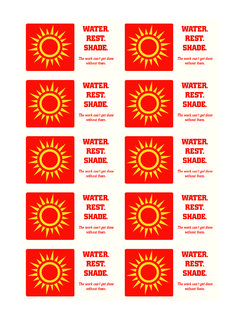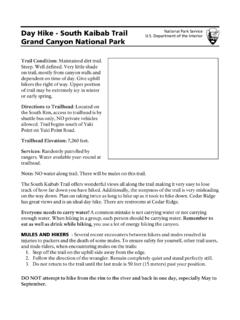Transcription of SUCCULENT CONTAINER GARDENING 101 - Texas Native Plants
1 SUCCULENT CONTAINER GARDENING 101 MATERIALS What you need! CONTAINER -- Be creative! Small piece of coco fiber, paper towel, or landscaper s cloth to cover the drainage hole Expanded shale, or gravel for drainage SUCCULENT /cactus soil Chopstick, bbq skewer, spoon, a small brush and other utensils for hard to reach areas Plants : Succulents, cacti, or sedum Optional: o Decorative gravel, stones or sand to achieve that finished look! o Charcoal used to keep containers with no drainage hole sweet and fresh. CARING FOR SUCCULENTS True love! Soil: Succulents and cacti thrive in well draining, porous soils. Gravel or expanded shale can be added to the bottom of the CONTAINER to help increase drainage.
2 A basic, sandy potting soil mixed with vermiculite makes a great SUCCULENT mix! Light: Succulents do very well in bright, indirect light-- most succulents will burn in direct sunlight. Although there are types of cacti that, in their natural environment thrive in full sun, we are mostly dealing with artificial growing conditions; therefore the Plants need some protection. Succulents and cacti grow well in a variety of places; a covered porch or patio, in a bright room, or in the shade of other Plants . Water: There are a couple of basics when it comes to watering succulents. 1. Never let the CONTAINER sit in a saucer of water. If your CONTAINER does not have a drainage hole, you will need to water less.
3 2. Never water a CONTAINER that does not feel dry (your finger is a great tool when testing moisture!). As a general rule, water once a week in the summer, or in warm conditions. In the wintertime, succulents and cacti need rest from watering to mimic their dry season. Mist Plants once or twice a week. Remember; always check that your soil is dry before you water! Temperature: Most succulents and cacti are not very frost hardy; some may not survive below 45 degrees. Exact hardiness depends on each individual plant. The good news about SUCCULENT CONTAINER gardens is that you can bring them inside for the chilly months! Feeding: Feed once a month with a cactus and SUCCULENT fertilizer, or one with low nitrogen and high phosphorus mixed at half strength.
4 Succulents don t need a lot of nitrogen because they grow slowly. Overfeeding will cause succulents to grow too quickly, after which they may need to be repotted. **Note: These are basic rules for most cactus, succulents and sedum. However, different varieties have slightly different growing needs. A cactus will need less water than most succulents and sedum will require more. Do some research to see what each little guy needs! STEP BY STEP GUIDE The how-to! 1. Select a CONTAINER that allows for drainage. A CONTAINER without any drainage holes is possible to use, however it should not be left where it may be rained on or drowned. Watering should also be closely monitored in these type of pots.
5 Succulents have shallow roots, so a shallow bowl or pot works well. 2. With your CONTAINER in mind, pick out some succulents! Think about your design and type of Plants and their specific care instructions. Generally, cacti grow well with other cacti, succulents grow well with other succulents and sedum like sedum. There are many varieties to choose from, so don t worry about not being able to mix cacti and succulents and sedum. If you feel confident trying to grow all three in the same pot, know that it is possible-- just not usually advised. 3. Keep in mind that when you do water your SUCCULENT CONTAINER , dirt may come out from the drainage hole making a mess. Use a small piece of coco fiber, or paper towel to just cover the drainage hole and prevent dirt from escaping.
6 4. Fill your CONTAINER halfway with potting mix, and if you choose to, some gravel or expanded shale. If your CONTAINER has no drainage hole, you may want to add a small layer of charcoal to the bottom of the pot to prevent any rotting or odors. 5. Carefully remove your succulents from their pots, holding by the base of the plant. Massage the pot if necessary to free the plant rather than pulling by the leaves. Place the Plants directly in your CONTAINER , trying not to disturb their delicate roots. It is good to have a design and an idea of placement for each plant before this step. Please use gloves if you re dealing with something sharp! 6. Now it s time to fill in all the little spaces between your Plants with soil, being careful not to plant above the level the SUCCULENT was planted in its nursery pot.
7 You don t want the soil to touch the crown, or base of your succulents. Be sure to fill in all the holes and spaces or else the roots will dry out and the Plants may die. 7. Most likely your succulents will have some soil stuck in the crevices and between leaves. Use a make-up brush or small paint brush to remove any dirt. You can also blow on the leaves, use a chopstick or skewer. 8. You are pretty much done with your CONTAINER garden, but now you have the option to top dress and decorate with some gravel or sand. This can make your CONTAINER garden go from blah, to wow! Different colors and sizes of stone and sand can change the tone and quality of your garden! Do you like zing and pop or refined, classy elegance?
8 The choice is yours! 9. Wait a few days before you water your new garden, then you may proceed with normal watering. DESIGN Imaginations run wild! CONTAINER garden design ideas vary from person to person. However, there are a few tips and tricks that help turn an average CONTAINER garden into a natural beauty! Color Choose colors wisely. If your pot is red, you may want to choose Plants that have hints of red and other warm colors to tie it all together. Number of Plants Different numbers of Plants in a CONTAINER can make or break a garden. Generally it is good to work with odd numbers (1, 3, 5, etc.) or even to fill every inch of the CONTAINER ! Arrangement The placement of your Plants can create movement and flow though your CONTAINER , drawing the eye from plant to plant.
9 Consider where to put your Plants to create a maximum effect! You are the artist Never let anyone dictate what looks good and what doesn t. It is your CONTAINER garden and you have the final say. Feel free to experiment and learn what you love!







